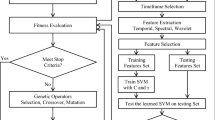Abstract
In this paper, an optimized support vector machine (SVM) based on a new bio-inspired method called magnetic bacteria optimization algorithm method is proposed to construct a high performance classifier for motor imagery electroencephalograph based brain–computer interface (BCI). Butterworth band-pass filter and artifact removal technique are combined to extract the feature of frequency band of the ERD/ERS. Common spatial pattern is used to extract the feature vector which are put into the classifier later. The optimization mechanism involves kernel parameters setting in the SVM training procedure, which significantly influences the classification accuracy. Our novel approach aims to optimize the penalty factor parameter C and kernel parameter g of the SVM. The experimental results on the BCI Competition IV dataset II-a clearly present the effectiveness of the proposed method outperforming other competing methods in the literature such as genetic algorithm, particle swarm algorithm, artificial bee colony, biogeography based optimization.







Similar content being viewed by others
References
Nicolas-Alonso LF, Gomez-Gil J (2012) Brain computer interfaces: a review. Sensors (Basel) 12:1211–1279. doi:10.3390/s120201211
Wolpaw JR, McFarland DJ, Vaughan TM (2000) Brain-computer interface research at the Wadsworth Center. IEEE Trans Rehabil Eng 8(2):222–226. doi:10.1109/86.847823
Blankertz B, Losch F, Krauledat M et al (2008) The Berlin brain–computer interface: accurate performance from first-session in BCI-naïve subjects. IEEE Trans Biomed Engi 55(10):2452–2462. doi:10.1109/TBME.2008.923152
Pfurtscheller G, Neuper C, Müller GR et al (2003) Graz-BCI: state of the art and clinical applications. IEEE Trans Neural Syst Rehabil Eng 11(2):177–180. doi:10.1109/TNSRE.2003.814454
Hortal E, Planelles D, Costa A et al (2015) SVM-based brain–machine Interface for controlling a robot arm through four mental tasks. Neurocomputing 151:116–121
Siuly Li Y (2014) A novel statistical algorithm for multiclass EEG signal classification. Eng Appl Artif Intell 34:154–167
Jrad N, Congedo M, Phlypo R et al (2011) sw-SVM: sensor weighting support vector machines for EEG-based brain–computer interfaces. J Neural Eng 8:056004. doi:10.1088/1741-2560/8/5/056004
Fu K, Qu J, Chai Y, Dong Y (2014) Classification of seizure based on the time-frequency image of EEG signals using HHT and SVM. Biomed Signal Process Control 13:15–22
Joshi V, Pachori RB, Vijesh A (2014) Classification of ictal and seizure-free EEG signals using fractional Linear prediction. Biomed Signal Process Control 9:1–5
Farina D, Nascimento OF, Lucas M-F, Doncarli C (2007) Optimization of wavelets for classification of movement-related cortical potentials generated by variation of force-related parameters. J Neurosci Methods 162:357–363
Dhiman R, Saini JS, Priyanka (2014) Genetic algorithms tuned expert model for detection of epileptic seizures from EEG signatures. Appl Soft Comput 19:8–17
Liu C, Wang H, Lu ZG (2013) EEG classification for multiclass motor imagery BCI. 2013 25th Chinese control and decision conference (CCDC). pp. 4450–4453
Subasi A (2013) Classification of EMG signals using PSO optimized SVM for diagnosis of neuromuscular disorders. Comput Biol Med 43:576–586
Aydin I, Karakose M, Akin E (2011) A multi-objective artificial immune algorithm for parameter optimization in support vector machine. Appl Soft Comput 11:120–129
Fei SW (2010) Diagnostic study on arrhythmia cordis based on particle swarm optimization-based support vector machine. Expert Syst Appl 37:6748–6752
Mo HW (2012) Research on magnetotactic bacteria optimization algorithm. The 5th international conference on advanced computational intelligence (ICACI 2012), Nanjing, 423–427. doi:10.1109/ICACI.2012.6463198
Mo HW, Xu LF (2013) Magnetotactic bacteria optimization algorithm for multimodal optimization. IEEE symposium on swarm intelligence (SIS), Sinpore, pp. 240–247
Mo HW, Liu LL, Xu LF, Zhao YY (2014) Performance research on magnetotactic bacteria optimization algorithm based on the best individual. The 6th international conference on bio-inspired computing (BICTA2014), Wuhan, pp. 318-322. doi:10.1007/978-3-662-45049-9_52
Mo HW, Geng MJ (2014) Magnetotactic bacteria optimization algorithm based on best-rand scheme. 6th Naturei and biologically inspired computing (NaBIC), Porto Portugal, pp. 59–64
Mo HW, Liu LL (2014) Magnetotactic bacteria optimization algorithm based on best-target scheme. International conference on nature computing and fuzzy knowledge, Xiamen, pp. 103–114: doi:10.1109/ICNC.2014.6975877
Mo HW, Liu LL, Xu LF (2014) A power spectrum optimization algorithm inspired by magnetotactic bacteria. Neural Comput Appl 25(7–8):1823–1844. doi:10.1007/s00521-014-1672-3
Mo HW, Liu LL, Geng MJ (2014) A new magnetotactic bacteria optimization algorithm based on moment migration. 2014 International conference on swarm intelligence, Hefei, pp. 103–114. doi:10.1007/978-3-319-11857-4_12
Nasihatkon B, Boostani R, Jahromi MZ (2009) An efficient hybrid linear and kernel CSP approach for EEG feature extraction. Neurocomputing 73:432–437
Golberg DE (1989) Genetic algorithms in search optimization and machine learning. Wesley, Reading
Kennedy J, Eberhart R (1995) Particle swarm optimization. IEEE international conference on neural networks. Piscataway, pp. 1942–1948
Tereshko V (1917) Reaction–diffusion model of a honeybee colony’s foraging behaviour. In: Schoenauer M (ed) Parallel problem solving from nature VI, lecture notes in computer science. Springer, Berlin, pp 807–816
Simon D (2008) Biogeography-based optimization. IEEE Trans on Evol Comput 12:702–713
Author information
Authors and Affiliations
Corresponding author
Rights and permissions
About this article
Cite this article
Mo, H., Zhao, Y. Motor Imagery Electroencephalograph Classification Based on Optimized Support Vector Machine by Magnetic Bacteria Optimization Algorithm. Neural Process Lett 44, 185–197 (2016). https://doi.org/10.1007/s11063-015-9469-7
Published:
Issue Date:
DOI: https://doi.org/10.1007/s11063-015-9469-7




